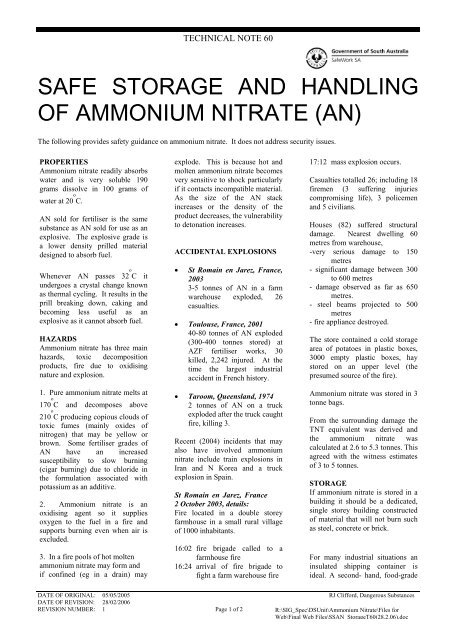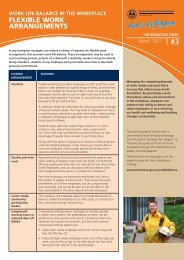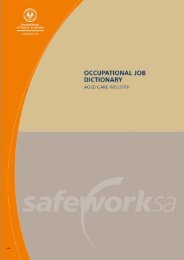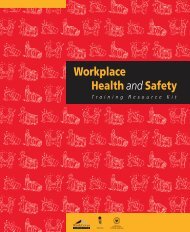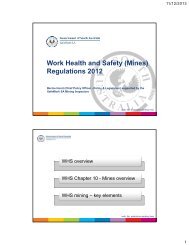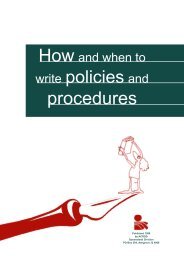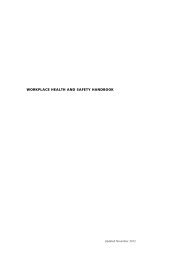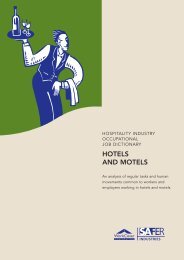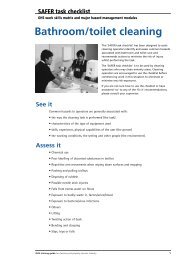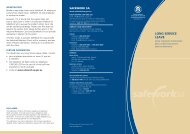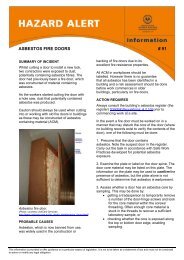safe storage and handling of ammonium nitrate - SafeWork SA
safe storage and handling of ammonium nitrate - SafeWork SA
safe storage and handling of ammonium nitrate - SafeWork SA
Create successful ePaper yourself
Turn your PDF publications into a flip-book with our unique Google optimized e-Paper software.
TECHNICAL NOTE 60<br />
<strong>SA</strong>FE STORAGE AND HANDLING<br />
OF AMMONIUM NITRATE (AN)<br />
The following provides <strong>safe</strong>ty guidance on <strong>ammonium</strong> <strong>nitrate</strong>. It does not address security issues.<br />
PROPERTIES<br />
Ammonium <strong>nitrate</strong> readily absorbs<br />
water <strong>and</strong> is very soluble 190<br />
grams dissolve in 100 grams <strong>of</strong><br />
water at 20 o<br />
C.<br />
AN sold for fertiliser is the same<br />
substance as AN sold for use as an<br />
explosive. The explosive grade is<br />
a lower density prilled material<br />
designed to absorb fuel.<br />
Whenever AN passes 32 o<br />
C it<br />
undergoes a crystal change known<br />
as thermal cycling. It results in the<br />
prill breaking down, caking <strong>and</strong><br />
becoming less useful as an<br />
explosive as it cannot absorb fuel.<br />
HAZARDS<br />
Ammonium <strong>nitrate</strong> has three main<br />
hazards, toxic decomposition<br />
products, fire due to oxidising<br />
nature <strong>and</strong> explosion.<br />
1. Pure <strong>ammonium</strong> <strong>nitrate</strong> melts at<br />
170 o<br />
C <strong>and</strong> decomposes above<br />
210 o<br />
C producing copious clouds <strong>of</strong><br />
toxic fumes (mainly oxides <strong>of</strong><br />
nitrogen) that may be yellow or<br />
brown. Some fertiliser grades <strong>of</strong><br />
AN have an increased<br />
susceptibility to slow burning<br />
(cigar burning) due to chloride in<br />
the formulation associated with<br />
potassium as an additive.<br />
2. Ammonium <strong>nitrate</strong> is an<br />
oxidising agent so it supplies<br />
oxygen to the fuel in a fire <strong>and</strong><br />
supports burning even when air is<br />
excluded.<br />
3. In a fire pools <strong>of</strong> hot molten<br />
<strong>ammonium</strong> <strong>nitrate</strong> may form <strong>and</strong><br />
if confined (eg in a drain) may<br />
explode. This is because hot <strong>and</strong><br />
molten <strong>ammonium</strong> <strong>nitrate</strong> becomes<br />
very sensitive to shock particularly<br />
if it contacts incompatible material.<br />
As the size <strong>of</strong> the AN stack<br />
increases or the density <strong>of</strong> the<br />
product decreases, the vulnerability<br />
to detonation increases.<br />
ACCIDENTAL EXPLOSIONS<br />
• St Romain en Jarez, France,<br />
2003<br />
3-5 tonnes <strong>of</strong> AN in a farm<br />
warehouse exploded, 26<br />
casualties.<br />
• Toulouse, France, 2001<br />
40-80 tonnes <strong>of</strong> AN exploded<br />
(300-400 tonnes stored) at<br />
AZF fertiliser works, 30<br />
killed, 2,242 injured. At the<br />
time the largest industrial<br />
accident in French history.<br />
• Taroom, Queensl<strong>and</strong>, 1974<br />
2 tonnes <strong>of</strong> AN on a truck<br />
exploded after the truck caught<br />
fire, killing 3.<br />
Recent (2004) incidents that may<br />
also have involved <strong>ammonium</strong><br />
<strong>nitrate</strong> include train explosions in<br />
Iran <strong>and</strong> N Korea <strong>and</strong> a truck<br />
explosion in Spain.<br />
St Romain en Jarez, France<br />
2 October 2003, details:<br />
Fire located in a double storey<br />
farmhouse in a small rural village<br />
<strong>of</strong> 1000 inhabitants.<br />
16:02 fire brigade called to a<br />
farmhouse fire<br />
16:24 arrival <strong>of</strong> fire brigade to<br />
fight a farm warehouse fire<br />
17:12 mass explosion occurs.<br />
Casualties totalled 26; including 18<br />
firemen (3 suffering injuries<br />
compromising life), 3 policemen<br />
<strong>and</strong> 5 civilians.<br />
Houses (82) suffered structural<br />
damage. Nearest dwelling 60<br />
metres from warehouse,<br />
-very serious damage to 150<br />
metres<br />
- significant damage between 300<br />
to 600 metres<br />
- damage observed as far as 650<br />
metres.<br />
- steel beams projected to 500<br />
metres<br />
- fire appliance destroyed.<br />
The store contained a cold <strong>storage</strong><br />
area <strong>of</strong> potatoes in plastic boxes,<br />
3000 empty plastic boxes, hay<br />
stored on an upper level (the<br />
presumed source <strong>of</strong> the fire).<br />
Ammonium <strong>nitrate</strong> was stored in 3<br />
tonne bags.<br />
From the surrounding damage the<br />
TNT equivalent was derived <strong>and</strong><br />
the <strong>ammonium</strong> <strong>nitrate</strong> was<br />
calculated at 2.6 to 5.3 tonnes. This<br />
agreed with the witness estimates<br />
<strong>of</strong> 3 to 5 tonnes.<br />
STORAGE<br />
If <strong>ammonium</strong> <strong>nitrate</strong> is stored in a<br />
building it should be a dedicated,<br />
single storey building constructed<br />
<strong>of</strong> material that will not burn such<br />
as steel, concrete or brick.<br />
For many industrial situations an<br />
insulated shipping container is<br />
ideal. A second- h<strong>and</strong>, food-grade<br />
DATE OF ORIGINAL: 05/05/2005 RJ Clifford, Dangerous Substances<br />
DATE OF REVISION: 28/02/2006<br />
REVISION NUMBER: 1 Page 1 <strong>of</strong> 2 R:\SIG_Spec\DSUnit\Ammonium Nitrate\Files for<br />
Web\Final Web Files\S<strong>SA</strong>N StorageT60(28.2.06).doc
container is already insulated <strong>and</strong><br />
lined with stainless steel <strong>and</strong> it can<br />
readily have an aluminium floor<br />
fitted.<br />
If <strong>ammonium</strong> <strong>nitrate</strong> is stored<br />
outside it should be protected from<br />
the weather.<br />
Keep <strong>ammonium</strong> <strong>nitrate</strong> dry as the<br />
risk <strong>of</strong> explosion increases once<br />
the product becomes caked.<br />
Avoid drains, channels <strong>and</strong> pits<br />
where molten <strong>ammonium</strong> <strong>nitrate</strong><br />
from a fire could become confined.<br />
Nitrate is a pollutant in waterways<br />
<strong>and</strong> aquifers. Storage sites should<br />
be selected to ensure no<br />
contamination <strong>of</strong> water, including<br />
that used in firefighting.<br />
Locate <strong>storage</strong> away from sources<br />
<strong>of</strong> heat, fire or explosion.<br />
Electrical equipment <strong>and</strong> wiring<br />
must be kept in good order <strong>and</strong> be<br />
regularly inspected as it can cause<br />
fires if faulty. Install main<br />
electrical switches <strong>and</strong> fuses<br />
outside the <strong>storage</strong> area to<br />
minimise the risk <strong>of</strong> fire.<br />
Except when stored in an insulated<br />
shipping container, do not store the<br />
<strong>ammonium</strong> <strong>nitrate</strong> closer than 1<br />
metre to walls <strong>and</strong> ro<strong>of</strong> <strong>and</strong> never<br />
within 1 metre from electrical<br />
wiring or lighting.<br />
Do not store <strong>ammonium</strong> <strong>nitrate</strong> in<br />
the same stack as other products.<br />
It is preferable to store <strong>ammonium</strong><br />
<strong>nitrate</strong> in a separate building from<br />
urea. If this cannot be achieved,<br />
store it so accidental mixing is<br />
prevented in any foreseeable<br />
accident situation. For example,<br />
use separate bays.<br />
Store <strong>ammonium</strong> <strong>nitrate</strong> away<br />
from combustible materials by a<br />
distance <strong>of</strong> at least 8 metres or use<br />
a barrier <strong>of</strong> inert material <strong>of</strong> at least<br />
1.5 metres width.<br />
Wooden pallets are a fire risk; do<br />
not store unused wooden pallets in<br />
the store unless separated by a<br />
suitable distance or barrier.<br />
Remove empty AN bags from the<br />
<strong>storage</strong> area.<br />
Prohibit smoking in <strong>storage</strong> areas<br />
<strong>and</strong> display NO SMOKING signs<br />
or symbolic prohibition signs.<br />
Outside the store there should be<br />
no combustible material within 8<br />
metres <strong>and</strong> no st<strong>and</strong>ing timber<br />
within 15 metres.<br />
Self-confinement <strong>of</strong> AN can<br />
increase the risk <strong>of</strong> detonation. It is<br />
preferable to limit stack sizes to 50<br />
tonnes.<br />
HOUSEKEEPING<br />
Keep vehicles, forklift trucks etc<br />
clean <strong>and</strong> well maintained to<br />
prevent <strong>ammonium</strong> <strong>nitrate</strong><br />
contacting fuel, oil or grease.<br />
Clean up spillages promptly <strong>and</strong><br />
dispose <strong>of</strong> contaminated product<br />
by dissolving in water before<br />
disposal.<br />
Do not use organic matter as a<br />
cleaning aid (eg sawdust), use inert<br />
material such as s<strong>and</strong> or<br />
vermiculite.<br />
Do not allow pallets, ropes,<br />
tarpaulins or other equipment to<br />
become impregnated with<br />
<strong>ammonium</strong> <strong>nitrate</strong>.<br />
Keep walls, floors <strong>and</strong> equipment<br />
clean.<br />
Avoid hollow sections in<br />
equipment to prevent build up <strong>of</strong><br />
<strong>ammonium</strong> <strong>nitrate</strong>. If unavoidable<br />
they must be regularly washed.<br />
Ensure any contaminated<br />
equipment is thoroughly washed to<br />
remove <strong>ammonium</strong> <strong>nitrate</strong> before<br />
allowing maintenance, particularly<br />
that involving heat, such as<br />
welding or cutting.<br />
AN can generally be disposed <strong>of</strong><br />
by dissolving in water <strong>and</strong> using as<br />
a fertiliser.<br />
INCOMPATIBLE MATERIAL<br />
Do not store <strong>ammonium</strong> <strong>nitrate</strong> in<br />
the same building as incompatible<br />
materials. The risk <strong>of</strong> fire or<br />
explosion is increased if<br />
<strong>ammonium</strong> <strong>nitrate</strong> is mixed with<br />
combustible or incompatible<br />
materials (including when molten<br />
in a fire) such as:<br />
• Flammable or combustible<br />
liquids such as petrol, diesel,<br />
oil, grease, paint,<br />
carbonaceous material.<br />
• Pressure vessels <strong>and</strong> gas<br />
cylinders.<br />
• Oil based pesticides.<br />
• Organic matter, such as hay,<br />
straw, grain <strong>and</strong> animal<br />
feedstuffs.<br />
• Sulphur.<br />
• Corrosive liquids, acids,<br />
alkalis <strong>and</strong> other reactive<br />
substances (oxidising or<br />
reducing) such as chlorates,<br />
hypochlorites, bleaching<br />
powder, nitrites, copper or<br />
chromium salts, chromates,<br />
permanganates.<br />
• Powdered metals, alkali<br />
metals, zinc or galvanised<br />
iron, copper or copper alloy.<br />
• Urea.<br />
• Chlorides.<br />
• Products which generate heat<br />
in the presence <strong>of</strong> moisture,<br />
such as quick-lime, <strong>and</strong><br />
calcium cyanamide.<br />
• Products, which will generate<br />
ammonia gas from the<br />
<strong>ammonium</strong> <strong>nitrate</strong>, such as<br />
cement, lime, basic slag <strong>and</strong><br />
other alkaline substances.<br />
• Other agricultural products<br />
whose behaviour towards<br />
<strong>ammonium</strong> <strong>nitrate</strong> is<br />
uncertain, for example<br />
br<strong>and</strong>ed pesticides,<br />
disinfectants or weedkillers.<br />
This information is provided to<br />
<strong>of</strong>fer guidance, it is not to be taken<br />
as a statement <strong>of</strong> law <strong>and</strong> must not<br />
be construed to waive or modify<br />
any legal obligation.<br />
DATE OF ORIGINAL: 05/05/2005 RJ Clifford, Dangerous Substances<br />
DATE OF REVISION: 28/02/2006<br />
REVISION NUMBER: 1 Page 2 <strong>of</strong> 2 R:\SIG_Spec\DSUnit\Ammonium Nitrate\Files for<br />
Web\Final Web Files\S<strong>SA</strong>N StorageT60(28.2.06).doc


